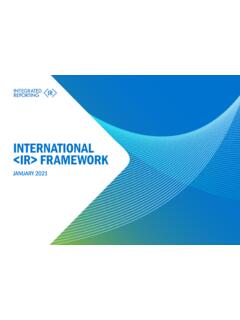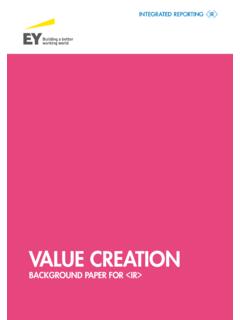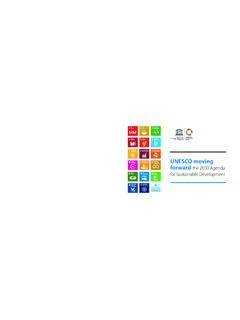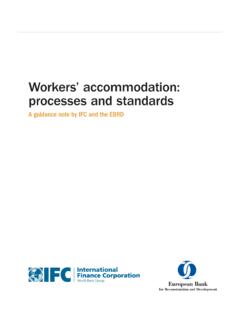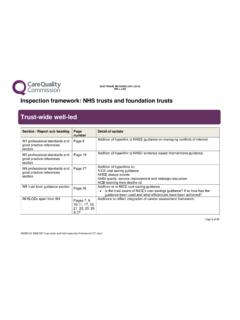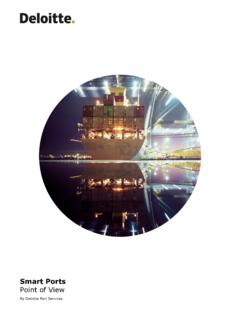Transcription of THE INTERNATIONAL IR FRAMEWORK
1 THE INTERNATIONAL <IR> FRAMEWORKABOUT THE IIRC The INTERNATIONAL Integrated Reporting Council (IIRC) is a global coalition of regulators, investors, companies, standard setters, the accounting profession and NGOs. Together, this coalition shares the view that communication about value creation should be the next step in the evolution of corporate reporting. The INTERNATIONAL <IR> FRAMEWORK has been developed to meet this need and provide a foundation for the future. Further information about the IIRC can be found on its website , including: The background to the IIRC s creation Its mission, vision and objectives Its structure and membership, and the membership of groups who have contributed to the development of this FRAMEWORK Its due process.
2 The IIRC does not accept responsibility for loss caused to any person who acts, or refrains from acting, in reliance on the material in this publication, whether such loss is caused by negligence or otherwise. Copyright December 2013 by the INTERNATIONAL Integrated Reporting Council ( the IIRC ). All rights reserved. Permission is granted to make copies of this work, provided that such copies are for personal or educational use and are not sold or disseminated and provided that each copy bears the following credit line: Copyright December 2013 by the INTERNATIONAL Integrated Reporting Council ( the IIRC ). All rights reserved. Used with permission of the IIRC.
3 Contact the IIRC for permission to reproduce, store, transmit or make other uses of this document. Otherwise, prior written permission from the IIRC is required to reproduce, store, transmit or make other uses of this document, except as permitted by law. Contact: The INTERNATIONAL <IR> FRAMEWORK 1 ABOUT INTEGRATED REPORTING The IIRC s long term vision is a world in which integrated thinking is embedded within mainstream business practice in the public and private sectors, facilitated by Integrated Reporting (<IR>) as the corporate reporting norm. The cycle of integrated thinking and reporting, resulting in efficient and productive capital allocation, will act as a force for financial stability and sustainability.
4 <IR> aims to: Improve the quality of information available to providers of financial capital to enable a more efficient and productive allocation of capital Promote a more cohesive and efficient approach to corporate reporting that draws on different reporting strands and communicates the full range of factors that materially affect the ability of an organization to create value over time Enhance accountability and stewardship for the broad base of capitals (financial, manufactured, intellectual, human, social and relationship, and natural) and promote understanding of their interdependencies Support integrated thinking, decision-making and actions that focus on the creation of value over the short, medium and long term.
5 <IR> is consistent with numerous developments in corporate reporting taking place within national jurisdictions across the world. It is intended that the INTERNATIONAL <IR> FRAMEWORK , which provides principles-based guidance for companies and other organizations wishing to prepare an integrated report, will accelerate these individual initiatives and provide impetus to greater innovation in corporate reporting globally to unlock the benefits of <IR>, including the increased efficiency of the reporting process itself. It is anticipated that, over time, <IR> will become the corporate reporting norm. No longer will an organization produce numerous, disconnected and static communications.
6 This will be delivered by the process of integrated thinking, and the application of principles such as connectivity of information. <IR> is consistent with developments in financial and other reporting, but an integrated report also differs from other reports and communications in a number of ways. In particular, it focuses on the ability of an organization to create value in the short, medium and long term, and in so doing it: Has a combined emphasis on conciseness, strategic focus and future orientation, the connectivity of information and the capitals and their interdependencies Emphasizes the importance of integrated thinking within the organization.
7 Integrated thinking is the active consideration by an organization of the relationships between its various operating and functional units and the capitals that the organization uses or affects. Integrated thinking leads to integrated decision-making and actions that consider the creation of value over the short, medium and long term. Integrated thinking takes into account the connectivity and interdependencies between the range of factors that affect an organization s ability to create value over time, including: The capitals that the organization uses or affects, and the critical interdependencies, including trade-offs, between them The capacity of the organization to respond to key stakeholders legitimate needs and interests How the organization tailors its business model and strategy to respond to its external environment and the risks and opportunities it faces The organization s activities, performance (financial and other) and outcomes in terms of the capitals past, present and future.
8 The more that integrated thinking is embedded into an organization s activities, the more naturally will the connectivity of information flow into management reporting, analysis and decision-making. It also leads to better integration of the information systems that support internal and external reporting and communication, including preparation of the integrated report. The INTERNATIONAL <IR> FRAMEWORK 2 CONTENTS EXECUTIVE SUMMARY 6 PART I INTRODUCTION 6 1. USING THE FRAMEWORK 7 A Integrated report defined 7 B Objective of the FRAMEWORK 7 C Purpose and users of an integrated report 7 D A principles-based approach 7 E Form of report and relationship with other information 8 F Application of the FRAMEWORK 8 G Responsibility for an integrated report 9 2.
9 FUNDAMENTAL CONCEPTS 10 A Introduction 10 B Value creation for the organization and for others 10 C The capitals 11 D The value creation process 13 PART II THE INTEGRATED REPORT 15 3. GUIDING PRINCIPLES 16 A Strategic focus and future orientation 16 B Connectivity of information 16 C Stakeholder relationships 17 D Materiality 18 E Conciseness 21 F Reliability and completeness 21 G Consistency and comparability 22 4. CONTENT ELEMENTS 24 A Organizational overview and external environment 24 B Governance 25 C Business model 25 D Risks and opportunities 27 E Strategy and resource allocation 27 F Performance 28 G Outlook 28 H Basis of preparation and presentation 29 I General reporting guidance 30 GLOSSARY 33 APPENDIX SUMMARY OF REQUIREMENTS 34 The INTERNATIONAL <IR> FRAMEWORK 3 EXECUTIVE SUMMARY Integrated Reporting (<IR>)
10 Promotes a more cohesive and efficient approach to corporate reporting and aims to improve the quality of information available to providers of financial capital to enable a more efficient and productive allocation of capital. The IIRC s long term vision is a world in which integrated thinking is embedded within mainstream business practice in the public and private sectors, facilitated by <IR> as the corporate reporting norm. AN INTEGRATED REPORT The primary purpose of an integrated report is to explain to providers of financial capital how an organization creates value over time. An integrated report benefits all stakeholders interested in an organization s ability to create value over time, including employees, customers, suppliers, business partners, local communities, legislators, regulators and policy-makers.

